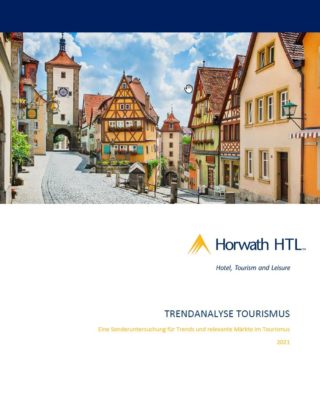Trend Study
By germanyeditor on 4. October 2021

Trend Study Tourism
A special study for tourism trends and relevant markets 2021
Over the last two decades, international tourism has experienced steady growth. While 674 million people travelled at the turn of the millennium, this figure had already risen to 1.5 billion by 2019. Declines were only recorded during the first SARS pandemic in 2003 (0.4 percent decrease) and during the international financial crisis in 2009 (four percent decrease). This development means that in some countries, tourism has become the most important economic force. According to the EU Commission’s Tourism Report, Croatia is the “front-runner” among the EU countries; there, income from tourism amounts to about 25 percent of the gross domestic product (GDP) and about a quarter of the total workforce is employed in this sector. The EU countries Cyprus, Greece and Portugal are also strongly dependent on tourism, with the travel industry accounting for about 20 percent of GDP. In comparison, the tourism sector in Germany is underrepresented: about twelve percent of total employment is within the tourism industry – and the share of just under one tenth of the country’s total economic output is also below that of the holiday countries in Europe.
This industry is a wide-ranging economic sector for many countries, including business and leisure travel as well as events. The value chain covers many areas and thus includes direct and indirect service providers. Despite – or because of – this booming development, tourism is also confronted with challenges: the industry is caught between unrestrained growth and fundamental changes. For example, the consequences of mass tourism/overtourism or the effects of travel on the climate are being critically discussed and partly questioned. In addition, there is also a change in business travel tourism due to the ever-closer merging of work and leisure. All these statements result in trends for tourism and markets that will be relevant for travel in the future and will be analysed in the following.
In the middle of structural and value change in tourism comes the Corona pandemic at the beginning of 2020, which brought with it a complete shutdown of the entire tourism value chain. The concrete consequences of this development are not yet foreseeable, but it is to be expected that the Corona crisis will be a trend accelerator for sustainable and reflective travel and thus, despite the major economic consequences,
opportunities will also arise at least for sub-sectors of the tourism industry. Although the Corona crisis is a turning point for the industry and leads to structural change, there will not be a complete turnaround from one day to the next. The tourism industry will recover – at least in the medium term – and start up again as soon as possible (unlike, for example, after a natural disaster or a war). Therefore, established trends and developments will remain largely the same for the time being from the current point of view but must now always be interpreted against the background of the Corona crisis.
This extensive study can be downloaded for free.